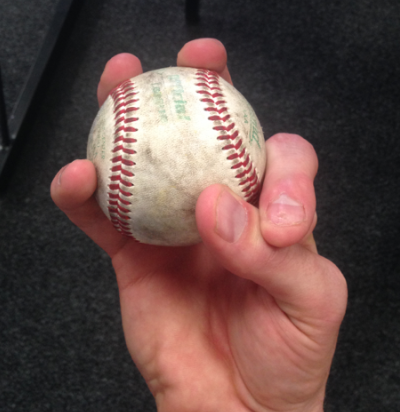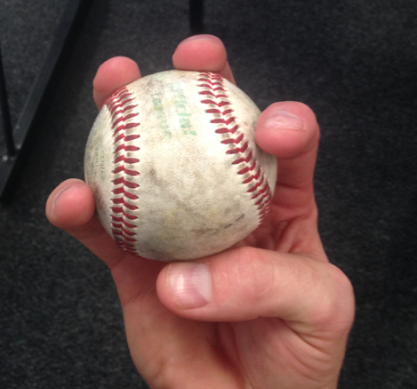Use These 3 Grips to Throw a Changeup They Can’t Hit
The best weapon in a pitcher’s arsenal is the changeup. No doubt “fad” pitches—in Roger Clemens’ day, it was the split-finger fastball; Mariano Rivera made the cutter famous—have revitalized careers and helped some pitchers achieve great success, but nothing takes the place of a good changeup.
I struggled to throw a changeup for years. I never needed one in high school (or so I thought), and in college, I was very successful without one. Playing professional baseball exposed my limited arsenal. Adding a changeup allowed me to move into a starting role and made pitching to lefties much more fun. My only regret with this pitch is that I did not master it earlier in my career.
I experimented with numerous grips to make my changeup work. I found success with some more than others. My hope here is to provide young pitchers with options to experiment with for grips and help them find one they can throw with confidence.
RELATED: Improve Your Curveball With These Tips and Drills
Why a Changeup Works
The answer is simple: A changeup fools the batter with the illusion that it’s a fastball. Hitters time the pitcher’s fastball and see the same arm speed on the changeup. But when they swing, their timing is disrupted.
Without aggressive, fastball arm speed, the changeup loses its effectiveness.
The physics of the pitch rely on a simple principle: friction. Adding more surface-area contact to the ball increases the friction leaving your hand. Under these conditions, it is impossible to throw the ball with the same velocity as a four- or two-seam fastball grip. This creates a discrepancy between the hitter’s timing of fastball velocity and the velocity of the actual pitch.
Changeup Grips
The Circle Change Grip
This is a standard grip most pitchers are taught at one point or another. It is the standard for a reason: it works. However, for young pitchers, the strict grip often makes controlling the pitch difficult. If you have the right size hand for it, it is a great pitch. I could not make it work for me, so I adapted it to fit my needs.
The Modified Circle Grip
I discovered, through trial and error, that if I softened up the “circle” portion of the grip with my index finger, I not only had much greater command, but also I could create a great deal of action on the pitch. This is the grip I used for much of my professional career.
The Claw Grip
This grip was great to learn on when I was beginning to develop confidence in the pitch. The grip is simple: touch your thumb to your pinky. The three other fingers should now look like claws. Simply slide the ball into your hand and rest the horseshoe portion of the seams on the pads of your hand. You are ready to throw.
Things to Remember
1. Down is better than up. The beauty of this pitch is that you don’t always have to pinpoint it. I learned to throw to an area rather than a spot early on. That allowed me room for error while I learned to command my changeup. Focus on hitting the back point of home plate with it, and you will be amazed at how many guys swing out of their shoes trying to hit it.
2. Allow the grip and wrist to create movement. Don’t force it. If you throw a straight change as opposed to an action change (one that moves), don’t overthrow it and force movement. The grips here will help you create action, organically reducing stress forces on the elbow and shoulder.
3. Focus on leading your release with your index finger. Overturning the wrist to make it move is not only counterproductive, but it can be damaging to young arms. I tell my pitching students to imagine slicing your catcher in half from the mask down with your index finger when releasing the baseball.
4. Be confident. My college pitching coach had a great saying: “A bad pitch thrown with confidence is better than a good one thrown in fear.” Believe you have a great changeup, even if it’s not where you want it to be, and throw it with confidence. The results will follow!
RELATED: How to Throw Harder: 4 Exercises to Gas Up Your Fastball
RECOMMENDED FOR YOU
Use These 3 Grips to Throw a Changeup They Can’t Hit
The best weapon in a pitcher’s arsenal is the changeup. No doubt “fad” pitches—in Roger Clemens’ day, it was the split-finger fastball; Mariano Rivera made the cutter famous—have revitalized careers and helped some pitchers achieve great success, but nothing takes the place of a good changeup.
I struggled to throw a changeup for years. I never needed one in high school (or so I thought), and in college, I was very successful without one. Playing professional baseball exposed my limited arsenal. Adding a changeup allowed me to move into a starting role and made pitching to lefties much more fun. My only regret with this pitch is that I did not master it earlier in my career.
I experimented with numerous grips to make my changeup work. I found success with some more than others. My hope here is to provide young pitchers with options to experiment with for grips and help them find one they can throw with confidence.
RELATED: Improve Your Curveball With These Tips and Drills
Why a Changeup Works
The answer is simple: A changeup fools the batter with the illusion that it’s a fastball. Hitters time the pitcher’s fastball and see the same arm speed on the changeup. But when they swing, their timing is disrupted.
Without aggressive, fastball arm speed, the changeup loses its effectiveness.
The physics of the pitch rely on a simple principle: friction. Adding more surface-area contact to the ball increases the friction leaving your hand. Under these conditions, it is impossible to throw the ball with the same velocity as a four- or two-seam fastball grip. This creates a discrepancy between the hitter’s timing of fastball velocity and the velocity of the actual pitch.
Changeup Grips
The Circle Change Grip
This is a standard grip most pitchers are taught at one point or another. It is the standard for a reason: it works. However, for young pitchers, the strict grip often makes controlling the pitch difficult. If you have the right size hand for it, it is a great pitch. I could not make it work for me, so I adapted it to fit my needs.
The Modified Circle Grip
I discovered, through trial and error, that if I softened up the “circle” portion of the grip with my index finger, I not only had much greater command, but also I could create a great deal of action on the pitch. This is the grip I used for much of my professional career.
The Claw Grip
This grip was great to learn on when I was beginning to develop confidence in the pitch. The grip is simple: touch your thumb to your pinky. The three other fingers should now look like claws. Simply slide the ball into your hand and rest the horseshoe portion of the seams on the pads of your hand. You are ready to throw.
Things to Remember
1. Down is better than up. The beauty of this pitch is that you don’t always have to pinpoint it. I learned to throw to an area rather than a spot early on. That allowed me room for error while I learned to command my changeup. Focus on hitting the back point of home plate with it, and you will be amazed at how many guys swing out of their shoes trying to hit it.
2. Allow the grip and wrist to create movement. Don’t force it. If you throw a straight change as opposed to an action change (one that moves), don’t overthrow it and force movement. The grips here will help you create action, organically reducing stress forces on the elbow and shoulder.
3. Focus on leading your release with your index finger. Overturning the wrist to make it move is not only counterproductive, but it can be damaging to young arms. I tell my pitching students to imagine slicing your catcher in half from the mask down with your index finger when releasing the baseball.
4. Be confident. My college pitching coach had a great saying: “A bad pitch thrown with confidence is better than a good one thrown in fear.” Believe you have a great changeup, even if it’s not where you want it to be, and throw it with confidence. The results will follow!
RELATED: How to Throw Harder: 4 Exercises to Gas Up Your Fastball













